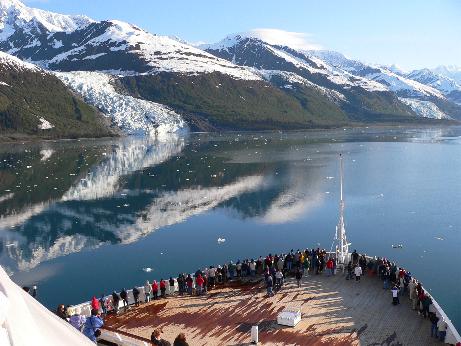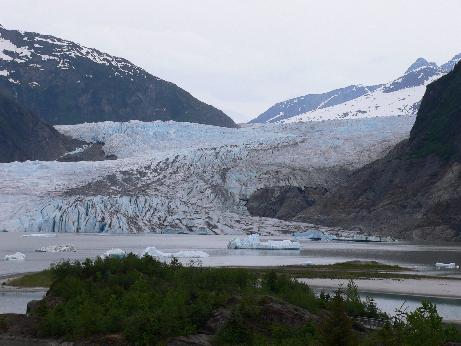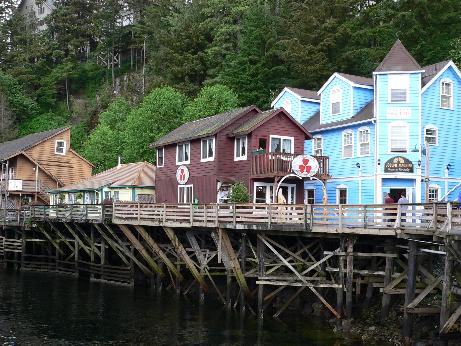Alaska
May 13 - 22, 2005

| Destination: Alaska May 13 - 22, 2005 |
 |
![]()
Just four months earlier in February, Kathy and I visited one end of the U.S. at Key West, Florida. We thought we should see the other end as well so we decided to head north to Alaska. I've been on two cruises and Kathy has been on three including an Alaska cruise but it had been several years since both of us last cruised.
Alaska has normally been one of the more expensive cruise destinations so we were quite surprised to find a deal on Holland America's ms Veendam for $549 plus tax per person (port taxes included). For that price, we could either get a confirmed inside cabin (one of the lowest categories) or take a chance and hold out for an upgrade. We decided to hold out for an upgrade and that was a good decision. We ended up being upgraded 15 categories to an outside cabin that was fairly spacious and even had a bath tub in the bathroom. Also, the cabin was located right in the middle of the ship.
We flew from Sacramento, California to Anchorage, Alaska with a stop in Seattle, Washington. We rented a car in Anchorage and drove directly to Earthquake Park which is located right near the airport. The park is located next to an area where a huge chunk of land slid into the Cook Inlet during the Good Friday earthquake in 1964. The earthquake measured 9.2 on the Richter Scale and was the strongest quake ever recorded in North America. It caused a tsunami that killed 12 people in Crescent City, California - the only fatal tsunami ever recorded in the lower 48 states.
|
The next day, we got up early and hit the road on a long journey to Denali National Park and Preserve located about 230 miles (370 km) from Anchorage on the Alaska Highway between Anchorage and Fairbanks. There was still a lot of snow on the ground and the scenery along the way was spectacular. In Denali National Park, you can only drive about 14 miles (22.5 km) into the park in your own vehicle. If you want to go the whole 90 miles (56 km) into the park, you have to pay to take the park bus. Since it was just the start of the season, the buses weren't going to start running until the next day but they let you drive your own vehicle about 30 (48 km) miles into the park instead of 14. The road is gravel from the 14th mile on. |
 Caribou in Denali National Park and Preserve |
On the drive through the park, we saw a moose, several caribou, three bears and a couple of willow ptarmigans, the state bird of Alaska. Unfortunately, we didn't have enough time to hike but just seeing the scenery and wildlife was a great experience.
 Mt. McKinley (Denali) |
Mt. McKinley (called Denali by the Native Americans) at 20,320' (6,193m) is the highest peak in North America. We were trying to see it all day but it was always hidden behind clouds. In fact, in the summer Mt. McKinley can only be seen one out of three days because of the weather. Finally, after we turned off the highway to stop at the town of Talkeetna for dinner on the way back to Anchorage, we saw the top third of Mt. McKinley sticking out above the clouds over 100 miles away. It was awesome and seeing that mountain made our little 570 mile (917 km) road trip perfect! |
We checked out of the motel the next day and drove a few blocks to downtown Anchorage where we walked around and saw the renovated Fourth Avenue Theatre, and the historic City Hall. Anchorage has a real small town atmosphere and they let us look around in the theatre without charging us. Fourth Avenue was heavily damaged during the big earthquake with large portions of the street dropping several meters.
After walking around Anchorage, we turned our rental car in at the airport and boarded the Holland America bus that would take us 125 miles (201 km) south on the Kenai Peninsula to the port of Seward. The drive to Seward had more great scenery. In fact, I was beginning to think that Alaska was one big National Park.
At one point along the way, our driver/tour guide pointed out hundreds of dead trees that were flooded from a tsunami after the Good Friday Earthquake. The salt water killed the trees but it also preserved them so their skeletons are still standing after 51 years - quite a strange site.
|
We boarded the ship in Seward, had our first meal and then did the obligatory life boat drill. It's always fun seeing how many wrong ways people can don life vests. The next day, we sailed into College Fjord. All the tidewater glaciers there are named after colleges - Wellesley, Vassar, Yale, Harvard, etc. It was cold out on deck but the sky was clear and the water was smooth as glass. All the mountains and glaciers were reflected in the water. It reminded me a little of Paradise Bay in Antarctica but the scenery here was even more spectacular. |
 College Fjord: Wellesley Glacier |
That night we had the first of two formal nights at dinner. Some of the men wore a tux but a regular suit is uncomfortable enough for me. The dinners were all five courses but the portions of each course weren't that big so I didn't feel uncomfortably stuffed after each meal. Of course everyone was trying to figure out which of the four spoons, forks and knives to use for each portion of the meal.
The next day, we entered Glacier Bay National Park and Preserve which is also a UNESCO World Heritage Site and an International Biosphere Reserve. There are 12 tidewater glaciers located throught the several inlets of the bay. Near the entrance, we picked up a park ranger who came out in a boat and he narrated as we cruised around the bay.
 Glacier Bay: Margerie Glacier |
We spent a lot of time watching the Margerie tidewater glacier which is 14 miles (22.5 km) long, 1 mile (1.6 km) wide and 250' (76m) high where it meets the water. We saw a few large chunks of ice break off (calve) into the water. Some of the glacier ice was really blue because it absorbs all colors of the visible light spectrum except blue, which it transmits. Glacier ice may also appear white because some ice is highly fractured with air pockets and indiscriminately scatters the visible light spectrum. |
We sailed into another section of Glacier Bay and saw some really spectacular mountains and glaciers. One glacier had what looked like a cave and you could see brown water falling from the top of the opening. The park ranger pointed out some bighorn sheep way up on a mountain but we didn't see them. He was really into the whole park exclaiming at one time that something really "blew his mind circuits".
After dinner, we went to one of the lounges and met a couple that sat at our dinner table. We formed a team to play "Name that Tune". The piano player only played a few notes of 10 songs and our team guessed the most so we each won a Veendam coffee mug.
Our first port was Sitka, the old Russian capital of Alaska. This was the only port where we had to take a tender from the ship to the shore. Sitka is small enough that we could easily walk to all the sites we planned to see.
 ms Veendam in Sitka Sound |
 Sitka |
Our first stop was the Sitka National Historical Site. It included a craft area where local Native Americans were making rugs, etching metal, etc. There was also a trail that included many totem poles and the site of a battle between the Russians and the Tlingit (pronounced klink-it) Indians. The site also includes a Russian Bishop's house built in the 1840s. Bishop Ivan Veniaminov who later became St. Innocent was its first resident. A park ranger gave us a tour of the house which included a chapel.
Next was a short walk to the Alaska Raptor Center, a place where injured raptors (eagles, hawks, owls, etc.) are taken to be treated. After treatment, the birds are either released, or if they can't survive in the wild anymore, they will live at the Raptor Center. One of the bald eagles there had been hit by a car in Oregon so they bring them in from all over.
|
Back towards town, we had a reindeer (caribou) sausage at a little outdoor mobile stand and enjoyed the sunny weather. We then visited a Russian Orthodox Church and Castle Hill, the site where Alaska was officially turned over by Russia to the United States in 1867. It also afforded a great view of the town, Sitka Sound and Mt. Edgecumbe, a 3,000' (914m) volcano 15 miles (24 km) away. We could see one tree that had four mature bald eagles sitting in it and we saw a few flying over the town. |
 Bald Eagle in the Alaska Raptor Center |
The next day we stopped in Juneau, Alaska's capital. We decided to take our one and only optional tour here - a bus trip to Mendenhall Glacier located about 13 miles (21 km) from Juneau. We had enough time for a short hike near the glacier and then headed back to Juneau.
 Mendenhall Glacier |
In Juneau, we walked to the capitol building and took the self-guided tour. We have been in several state capitol buildings and this one was very different. From the outside, it looked like a regular office building. When we went in, there was a sign at the metal detector that said: "Guard will return in 10 minutes." or something like that so we just went on in. We checked out the Assembly and Senate chambers which looked similar to those in other capitols only much smaller. Heading back toward town, we passed by the Governor's Mansion and ended up at the Red Dog Saloon for a beer. This place had the usual eclectic décor of a tourist saloon as well as a piano player playing beer drinking songs including "North to Alaska". One sign on the wall read: "If our service and food are not up to your standards, please lower your standards". |
We arrived at our third and final port the next day - Ketchikan, the "Salmon Capital of Alaska". I was amazed as our ship "parallel parked" between two other huge cruise docked at the pier - the Princess ship "Dawn Princess" and the NCL ship "Norwegian Star". Again, everything was within walking distance including Creek Street, the infamous red light district where you can still tour Dolly's House. Most of the old buildings there are now fancy tourist shops. I broke down and bought some smoked salmon to take home. You could also see a lumberjack competition show there but we enjoyed just walking around.
| Like Juneau and Sitka, there are no roads connecting
Ketchikan to other towns. To get to these towns, you either have to fly or take
a boat or ship. Everyone has to have their cars shipped in. On this cruise, we saw humpback whales, dolphins and sea otters but no orcas. The last afternoon on the ship, we went up to the Crow's Nest lounge to look for orcas. We were sailing though the narrow Canadian Inside Passage and there was one area that was supposed to have a pod of 200 orcas. I actually sat up there with my binoculars for five hours even skipping the last dinner looking for orcas but they were all hiding. Kathy brought me some dessert and I got in on the buffet on the Lido deck just before it closed so I didn't starve. |
 Ketchikan: Creek Street |
That night, we had to have our bags outside our stateroom door by 1:00 a.m. as we were arriving in Vancouver fairly early the next morning. After packing and putting our bags out, we decided to head up to the Crow's Nest for one last party. It was Canadian night there and they asked Canadian trivia questions. I answered one question with the help of the DJ and won a free drink. Then Kathy won a drink by answering a question about what the Canadian dollar coin is called (Loonie) with a little help from a certain coin collector. There was a group of Australian travel agents (all women) there that were also having a great time (on company time, no doubt).
After arriving in Vancouver the next morning, we boarded the bus to the airport and our bus driver gave us some information about the city along the way. At the airport, I was surprised that we went through U.S. Customs and Immigration right there even though we were still in Canada. We flew back to Sacramento with a few hour layover in Portland.
Our ship, the Veendam is one of the older medium size cruise ships that has recently had a complete renovation. It holds 1,266 passengers and there were 1,209 on our cruise. We never felt crowded on the ship. In fact, there were times when the ship almost seemed abandoned. Some of the newer ships hold over 3,000 passengers as each line keeps vying for the biggest ship title. Royal Caribbean's Freedom of the Seas will hold 4,370 passengers when it sails in June, 2006.
 The No-Diet Zone |
The Holland America ships are more elegant than many of the other cruise lines' ships. They really go in for nice artwork and flower displays and don't use really wild colors found in many other ships - a much more pleasant atmosphere. Ten years before this cruise, when I was a part-time travel agent, I inspected the Veendam's sister ship, the ms Ryndam in San Francisco. Coincidentally, Kathy was also a travel agent back then and also went to inspect the Ryndam on the same day. The Veendam is very similar to the Ryndam so we both knew the ship would be nice. Of course we never got bored on the ship. In between ports, we saw two live song and dance type shows, comedians, a movie, played bingo and Kathy entered the wiffle golf ball contest by the pool. |
Holland America offered 74 optional shore excursions that you could sign up for. The prices ranged from $30 to $449 per person for floatplane flights and helicopter/hiking trips to glaciers.
One other thing that has changed on cruises is after several epidemics on other ships over the last several years, they stress personal hygiene. There are hand sanitizer dispensers located throughout the ship and when we went to meet the Captain (who looks like Billy Bob Thornton) at the Captain's cocktail party, one of the Assistant Cruise Directors stood guard and informed us that the Captain will not shake our hands. They even made an announcement one time discouraging shaking hands with anyone on the ship.
Another thing Holland America does now is add all customary tips to your charge card. If you want to tip more, less or not at all, you let them know at the end of the cruise and they will adjust your bill. To me, this is a better way than handing out envelopes containing the tips at the end of the cruise.
You can also purchase wine packages and soft drink cards that will let you drink an unlimited amount of soft drinks on the cruise. Maybe some day they'll finally go "all inclusive" but they would have to jack the price up a bit.
We sailed 1,821 nautical miles (2,096 miles/3,373 km). The seas were mostly very calm and the weather was great overall. It rained a little on the drive to Seward and in Juneau, but the weather in College Fjord and in Sitka was beautiful. From our experience, this was a good time to cruise Alaska where it can be cold and rainy even in August. If you're looking for beautiful scenery, great wildlife viewing and some interesting ports and don't mind forgoing the warm tropical climates, Alaska is a great place to cruise!
 |
![]()